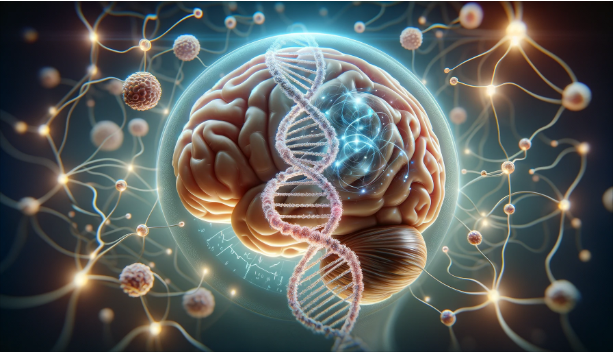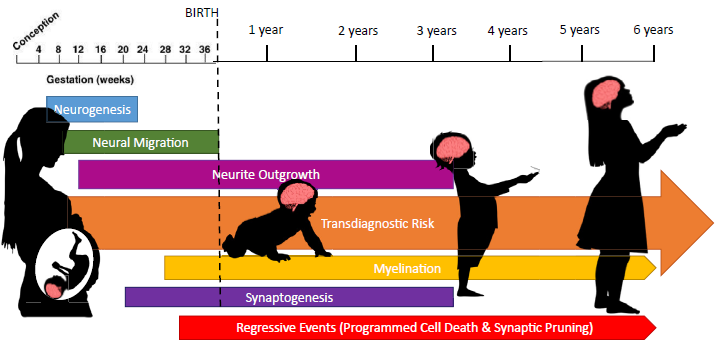|
Neurogenetics
Have you ever wondered why you think, feel, and behave the way you do? What if the answers lie deep within your DNA, intertwined with the very fabric of your nervous system? Welcome to the captivating world of neurogenetics, a field that merges the mysteries of the brain with the codes of our genes, promising to unravel the secrets behind our neurological health, cognitive abilities, and much more.
Why do some people face a higher risk of neurological diseases while others do not? Can our genetic makeup predict our mental health, or even influence our learning capacity and memory? How much of who we are is written in our DNA, and how do these genetic scripts play out in the complex theatre of our minds? These are the questions at the heart of neurogenetics.
Neurogentics is a discipline that tries to answer these questions at the basis on genetics and this field tries to attempts to better understand genetic causes of brain disorders and genetic background behind normal brain processes

Followings are some of the details we want to look into in this note :
How do genetic variations influence the brain's evolution from infancy, potentially setting the path for future mental health? Could the key to understanding and preventing neuropsychiatric disorders lie within our genes from the earliest stages of brain development?
This journey to find the answers to these questions explores how genetics and brain development intersect from an early age. It highlights the significant role that our genetic makeup plays in forming the brain's structure. Additionally, it examines how these genetic factors can influence the risk of developing neuropsychiatric conditions.

Image Source : Genetic Influences on the Developing Young Brain and Risk for Neuropsychiatric Disorders
The above image illustrates the developmental timeline of the human brain from conception through early childhood, highlighting critical processes such as neurogenesis, neural migration, neurite outgrowth, synaptogenesis, and myelination.
Do our genes decide how our brain works? Can small changes in our DNA explain why some people have brain disorders? In the field of neurogenetics, doctors and scientists study how certain genes can cause brain diseases. These diseases, like Huntington's or Alzheimer's, affect many people around the world. We are learning how these diseases start, and how our genes play a role in them. Let's learn together about how the stories in our genes can affect our brain health.
- Huntington’s Disease:
-
A progressive brain disorder causing uncontrolled movements, emotional problems, and loss of cognition.
-
Caused by a genetic mutation that involves a repeated DNA sequence.
- Kennedy’s Disease:
-
Also known as Spinal and Bulbar Muscular Atrophy (SBMA), a condition that weakens muscles and affects the motor neurons.
-
It's an X-linked recessive disorder linked to mutations in the androgen receptor gene.
- Spinocerebellar Ataxia:
-
A group of hereditary conditions that lead to progressive difficulties with coordination, gait, and speech.
-
Caused by mutations that affect the cerebellum, the part of the brain controlling movement.
- Spinal Muscular Atrophy:
-
A genetic disorder characterized by weakness and wasting in the voluntary muscles, especially near the center of the body.
-
Often linked to a genetic defect in the SMN1 gene.
- Hereditary Motor Neuron Disease:
-
A group of disorders that selectively affect motor neurons, the cells that control voluntary muscles.
-
Genetic causes can vary but result in muscle weakness and atrophy.
- Early Onset Muscle Disorders:
- Charcot-Marie-Tooth Neuropathies:
-
A group of inherited disorders that affect the peripheral nerves.
-
Characterized by muscle weakness and atrophy, and sensory loss.
- Hereditary Spastic Paraplegias:
- Friedreich’s Ataxia:
-
An inherited disease that causes progressive damage to the nervous system resulting in symptoms ranging from gait disturbance and speech problems to heart disease.
-
It's associated with a genetic mutation that disrupts cellular production of frataxin.
- Muscular Dystrophies (Duchenne and LGMD):
-
Duchenne: A severe type of muscular dystrophy that causes muscle degeneration and weakness.
-
LGMD (Limb-Girdle Muscular Dystrophy): A group of disorders that affect the voluntary muscles, primarily those around the hips and shoulders.
- Congenital Muscular Dystrophies and Myopathies:
-
A varied group of muscular dystrophies that are present at birth or in early infancy.
-
Characterized by muscle weakness and developmental problems, often due to defects in muscle proteins.
Neurogenesis, the process of generating new neurons in the brain, is governed by a complex interplay of genes that are critical for various stages of brain development and function. Key genes orchestrate a myriad of tasks, from maintaining the pluripotency of neural stem cells to directing their differentiation into mature neurons. These genes not only ensure the proper growth and integration of neurons but also play significant roles in the overall structure and functionality
of the brain. Understanding the roles of these genes is essential for deciphering the biological underpinnings of neural development and for addressing various neurological disorders linked to aberrations in these processes.
-
Notch signaling pathway genes:Notch1, Notch2, Jagged1, Delta-like ligand 1 (Dll1). These genes are crucial for maintaining the balance between neural stem cell self-renewal and differentiation.
-
Neurotrophic factors: Brain-derived neurotrophic factor (BDNF), nerve growth factor (NGF), and glial cell-derived neurotrophicfactor (GDNF). These molecules promote the survival, growth, and differentiation of neurons.
-
Transcription factors:Sox2, Pax6, NeuroD1, and Tbr2. These proteins regulate the expression of other genes involved in neurogenesis, controlling the timing and fate of neural progenitor cells.
-
Wnt signaling pathway genes:Wnt3a, Wnt7a, and β-catenin. These genes are involved in regulating the proliferation and differentiation of neural stem cells.
-
Sonic hedgehog (Shh) signaling pathway genes:Shh, Patched1, and Smoothened. These genes play a role in patterning the developing nervous system and regulating neurogenesis in specific brain regions.
Are there any age dependant genes/factors ?
Yes, there are many age-dependent genes and factors(i.e, expressed in different phases of neural development) involved in neurogenesis, with their expression levels varying across different phases of neural development.
Embryonic Neurogenesis:
-
Sox family genes: Sox1, Sox2, and Sox3 are crucial for maintaining the neural stem cell pool and promoting their self-renewal.
-
Pax family genes: Pax6 is essential for early patterning of the developing brain and the specification of neural progenitors.
-
Neurogenins: Neurog1 and Neurog2 promote the differentiation of neural progenitors into neurons.
-
Hes family genes: Hes1 and Hes5 are involved in regulating the timing of neurogenesis and maintaining the balance between progenitor proliferation and differentiation.
-
proneural bHLH transcription factors: Ascl1 (Mash1) and Atoh1 (Math1)
Postnatal Neurogenesis:
-
Doublecortin (DCX): This microtubule-associated protein is expressed in newly born neurons during migration and differentiation.
-
Polysialylated-neural cell adhesion molecule (PSA-NCAM): This glycoprotein is involved in cell migration and synaptic plasticity.
-
Tbr2: This transcription factor is crucial for the specification and differentiation of intermediate neural progenitors.
-
NeuroD1: This transcription factor regulates neuronal differentiation and maturation.
Adult Neurogenesis:
-
Sox2: This transcription factor remains essential for maintaining the neural stem cell niche in the adult brain.
-
GFAP: This intermediate filament protein is a marker of astrocytes, which play a supportive role in neurogenesis.
-
Nestin: This intermediate filament protein is expressed in neural stem cells and early progenitor cells.
-
Ascl1: This transcription factor regulates the differentiation of adult neural stem cells into neurons.
Aging:
-
REST (Repressor Element 1-Silencing Transcription factor): This transcriptional repressor increases its expression with age and is thought to inhibit neuronal gene expression.
-
p16INK4a: This cyclin-dependent kinase inhibitor accumulates with age and is implicated in cellular senescence, including neural stem cells.
Other factors:
In addition to these genes, epigenetic modifications, microRNAs, and environmental factors also play significant roles in age-dependent neurogenesis.
Reference
YouTube
|
|

